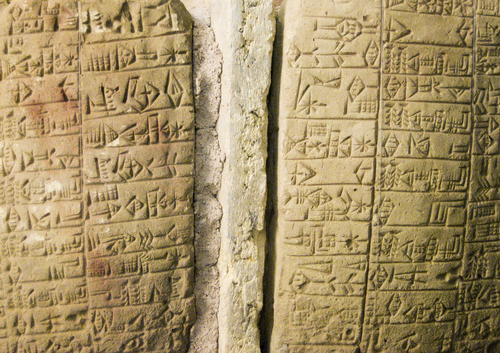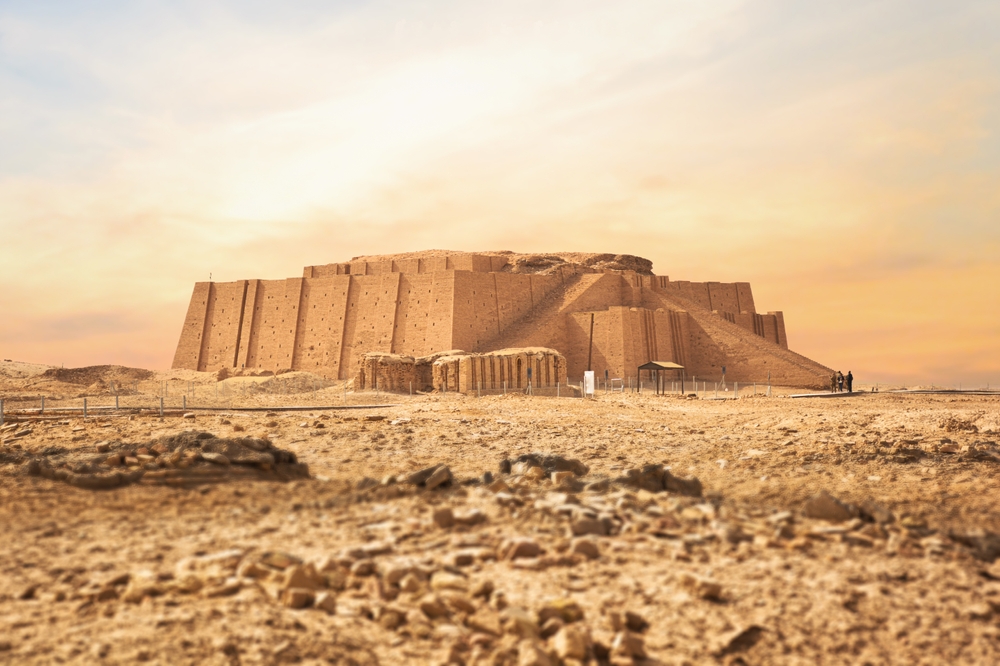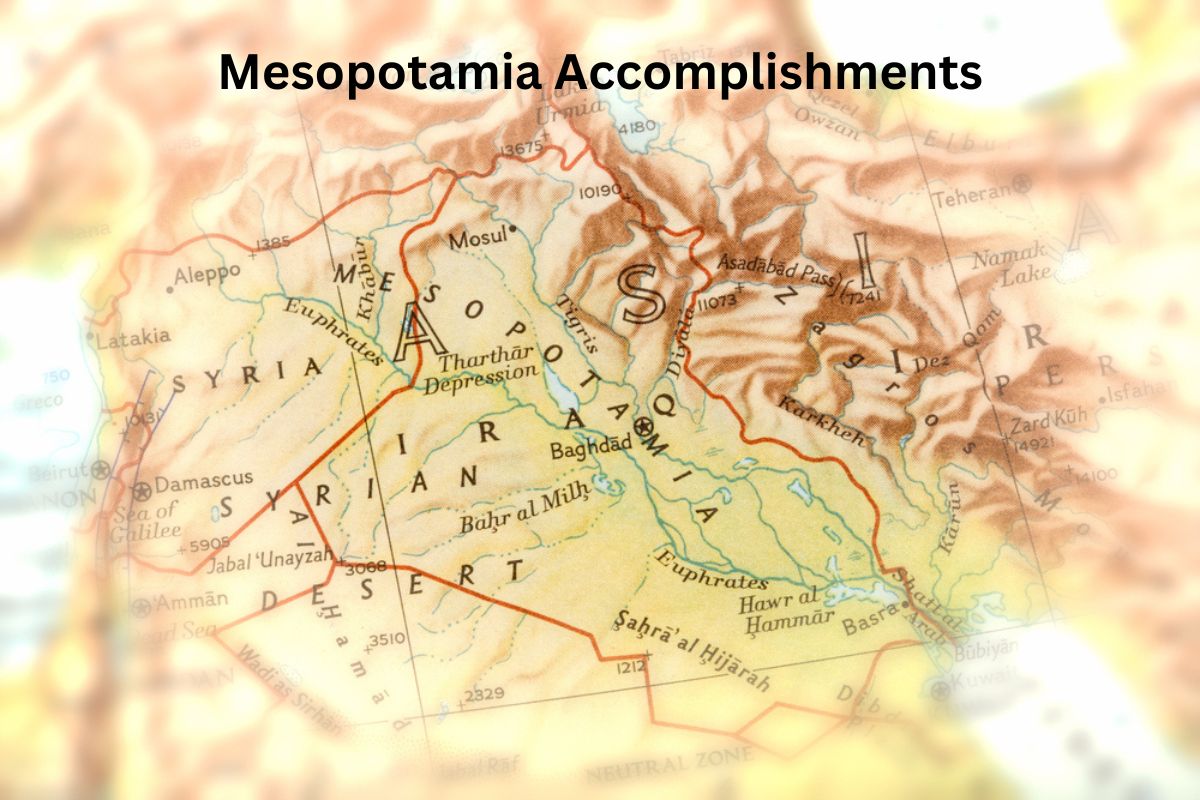Mesopotamia, located in present-day Iraq, was a region known for its significant contributions to human civilization.
Considered one of the cradles of civilization, Mesopotamia witnessed numerous accomplishments that shaped various fields of knowledge.
From the invention of writing and the development of mathematics to the construction of monumental structures and advancements in medicine, Mesopotamia’s achievements left an indelible mark on human history.
Through their innovations in agriculture, architecture, astronomy, and legal systems, the Mesopotamians paved the way for future civilizations and laid the foundation for the advancements that continue to shape our world today.
Accomplishments of Mesopotamia
1. Invention of Writing (Cuneiform)
Mesopotamia is credited with the development of one of the earliest writing systems in the world, known as cuneiform. Around 3200 BCE, the Sumerians of Mesopotamia began using a system of pictographs to represent objects and ideas.
Also Read: Facts About Mesopotamia
Over time, these pictographs evolved into a more abstract system of wedge-shaped marks pressed into clay tablets, known as cuneiform. This writing system allowed for the recording of laws, literature, religious texts, administrative records, and other important information.
Cuneiform had a profound impact on the preservation and transmission of knowledge, influencing later writing systems and paving the way for the development of written literature and historical records.

2. Creation of the Wheel
The Mesopotamians are credited with inventing the wheel, one of the most significant technological advancements in human history.
Around 3500 BCE, they developed the concept of a wheel made of solid wooden disks. Initially, the wheel was used in pottery-making and as a means to transport heavy objects.
Also Read: Timeline of Mesopotamia
However, its potential as a mode of transportation was soon recognized, leading to the development of wheeled vehicles such as carts and chariots.
The wheel revolutionized transportation, making it easier to move goods, people, and armies, and it had a profound impact on trade, agriculture, and warfare.
3. Development of Mathematics
Mesopotamia made significant strides in mathematics, contributing to the development of foundational concepts and systems that influenced later mathematical thinking.
The Mesopotamians used a base-60 numerical system, known as the sexagesimal system, which has influenced modern concepts like the division of hours, minutes, and seconds.
They developed methods for performing arithmetic calculations, including addition, subtraction, multiplication, and division, using clay tablets and a sophisticated system of symbols.
Mesopotamian mathematicians also made advancements in geometry, developing formulas to calculate areas and volumes of various shapes.
Their mathematical achievements laid the groundwork for future mathematical advancements in other civilizations, such as ancient Greece.
4. Construction of Ziggurats
Ziggurats were monumental stepped structures built in Mesopotamia as religious temples. These impressive architectural achievements served as focal points of worship and were often dedicated to a specific deity.
Also Read: Ziggurats Facts
Ziggurats were made of mud bricks and featured multiple terraces, with each level diminishing in size as it ascended. The top of the ziggurat held a shrine or temple, and it was believed to be the meeting point between the heavens and the earth.
Ziggurats served as the centers of religious and administrative life in Mesopotamian city-states, and they symbolized the power and authority of the ruling elite.
Their construction required extensive labor and engineering expertise, showcasing the advanced architectural skills of the Mesopotamians.

5. Introduction of Legal Systems (Code of Hammurabi)
Mesopotamia played a crucial role in the development of legal systems. The most famous legal code from Mesopotamia is the Code of Hammurabi, created around 1754 BCE during the reign of King Hammurabi of Babylon.
The Code of Hammurabi consisted of 282 laws that regulated various aspects of society, including trade, property, family matters, and criminal offenses. It aimed to establish justice and maintain social order.
The code followed the principle of “an eye for an eye” and included laws for different social classes, providing guidelines for behavior and punishment.
The Code of Hammurabi influenced later legal systems in the region and beyond, leaving a lasting impact on the concept of law and justice.
6. Irrigation Systems
Mesopotamia developed sophisticated irrigation systems to harness the waters of the Tigris and Euphrates rivers. These rivers were the lifeblood of the region, but their seasonal floods posed challenges for agriculture.
To overcome this, the Mesopotamians constructed canals, dikes, and reservoirs to control the flow of water and distribute it to farmland.
They also built levees to protect settlements from floods. These irrigation systems allowed for the cultivation of crops in arid regions, transforming Mesopotamia into a fertile agricultural landscape.
The increased agricultural productivity supported a growing population, enabled surplus food production, and contributed to the development of urban centers and complex societies in the region.
The knowledge and techniques of Mesopotamian irrigation systems influenced future civilizations in managing water resources for agriculture.
7. Astrology and Astronomy
Mesopotamia had a profound interest in studying celestial bodies and developed a complex system of astrology.
Mesopotamian astronomers observed the movements of the stars, planets, and other celestial objects and believed that they held significant influence over human affairs.
They developed an intricate system of celestial omens and interpretations, associating the positions and alignments of celestial bodies with events on Earth.
Mesopotamian astrologers provided guidance on matters such as agriculture, weather, warfare, and the ruling of kings. Moreover, their observations of the night sky laid the foundation for later advancements in astronomy, including the cataloging of stars and the measurement of time.
8. Innovations in Architecture
Mesopotamian architecture showcased several innovations that influenced subsequent architectural styles.
They were among the first to use the arch and vault in construction, which enabled the creation of larger and more durable structures. Mesopotamian architects designed and built monumental structures such as palaces, temples, city walls, and gates. These buildings were made using mud bricks, which were widely available in the region.
Mesopotamian architecture also incorporated decorative elements such as colorful glazed tiles and intricate carvings. The architectural achievements of Mesopotamia laid the foundation for the development of architectural styles in later civilizations, leaving a lasting impact on the history of architecture.
9. Introduction of the Lunar Calendar
Mesopotamia developed one of the earliest known calendars based on the cycles of the Moon. The Mesopotamians observed the regular phases of the Moon and devised a lunar calendar consisting of twelve lunar months.
Each month began with the sighting of the new Moon, marking the start of a new lunar cycle. The lunar calendar was adjusted to align with the solar year by adding intercalary months or days.
This calendar system played a significant role in religious and agricultural practices, guiding the timing of religious festivals, agricultural activities, and the management of time in general. The concept of a lunar calendar influenced subsequent civilizations in the region and beyond.
10. Advancements in Medicine
Mesopotamians made noteworthy contributions to the field of medicine. They observed and documented various ailments, developing diagnostic methods and treatments.
Mesopotamian medical texts, such as the Diagnostic Handbook and the Medical Diagnostic List, recorded symptoms, diseases, and treatments using herbal remedies and other techniques. They recognized the importance of hygiene, sanitation, and surgical procedures.
Mesopotamian medicine also incorporated magical and religious elements, as healers often invoked deities for assistance in healing. The medical knowledge and practices of Mesopotamia influenced later civilizations in the region, including ancient Greece and Egypt, and laid the groundwork for future medical advancements.
